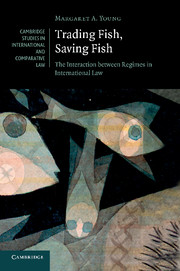Book contents
- Frontmatter
- Contents
- Foreword
- Acknowledgements
- Table of cases
- Table of Conventions, Declarations and procedures
- List of abbreviations
- Part I Trading Fish, Saving Fish
- Part II Selected Case Studies
- Chapter 3 The negotiation of WTO rules on fisheries subsidies
- Chapter 4 The restriction of trade in endangered marine species
- Chapter 5 Adjudicating a fisheries import ban at the WTO
- Part III Towards Regime Interaction
- Appendices
- Bibliography
- Index
- CAMBRIDGE STUDIES IN INTERNATIONAL AND COMPARATIVE LAW
- References
Chapter 4 - The restriction of trade in endangered marine species
Published online by Cambridge University Press: 28 April 2011
- Frontmatter
- Contents
- Foreword
- Acknowledgements
- Table of cases
- Table of Conventions, Declarations and procedures
- List of abbreviations
- Part I Trading Fish, Saving Fish
- Part II Selected Case Studies
- Chapter 3 The negotiation of WTO rules on fisheries subsidies
- Chapter 4 The restriction of trade in endangered marine species
- Chapter 5 Adjudicating a fisheries import ban at the WTO
- Part III Towards Regime Interaction
- Appendices
- Bibliography
- Index
- CAMBRIDGE STUDIES IN INTERNATIONAL AND COMPARATIVE LAW
- References
Summary
RECOGNIZING the primary role of sovereign States, FAO and regional fisheries management organizations in fisheries conservation and management …
As commercially significant and heavily traded species such as basking sharks and bluefin tuna become threatened with depletion, questions arise about the role of existing regimes and novel interactions.
This chapter explores the efforts within international law to restrict the trade in endangered marine species. The increasing trade in fish and fish products has accompanied a drastic decline in numbers of certain marine species. Stalling and reversing the depletion of these species gives rise to interaction between two prominent regimes: the FAO fisheries management regime and the CITES regime that regulates the international trade in endangered species. The Secretariats of CITES and the FAO have worked closely to address the potential large-scale depletion of selected marine species, including some that are commercially valuable and heavily traded, such as sharks, queen conch and the bluefin tuna.
Rather than initiating new law, as was done in the regime interaction considered in the previous chapter, efforts to restrain international trade in marine species have involved the implementation of existing legal commitments. The implementation of these commitments requires collaboration and coordination between the FAO and CITES regimes. Countries have proposed to entrench this interaction through a Memorandum of Understanding (MOU) between the FAO and CITES Secretariats.
- Type
- Chapter
- Information
- Trading Fish, Saving FishThe Interaction between Regimes in International Law, pp. 134 - 188Publisher: Cambridge University PressPrint publication year: 2011



